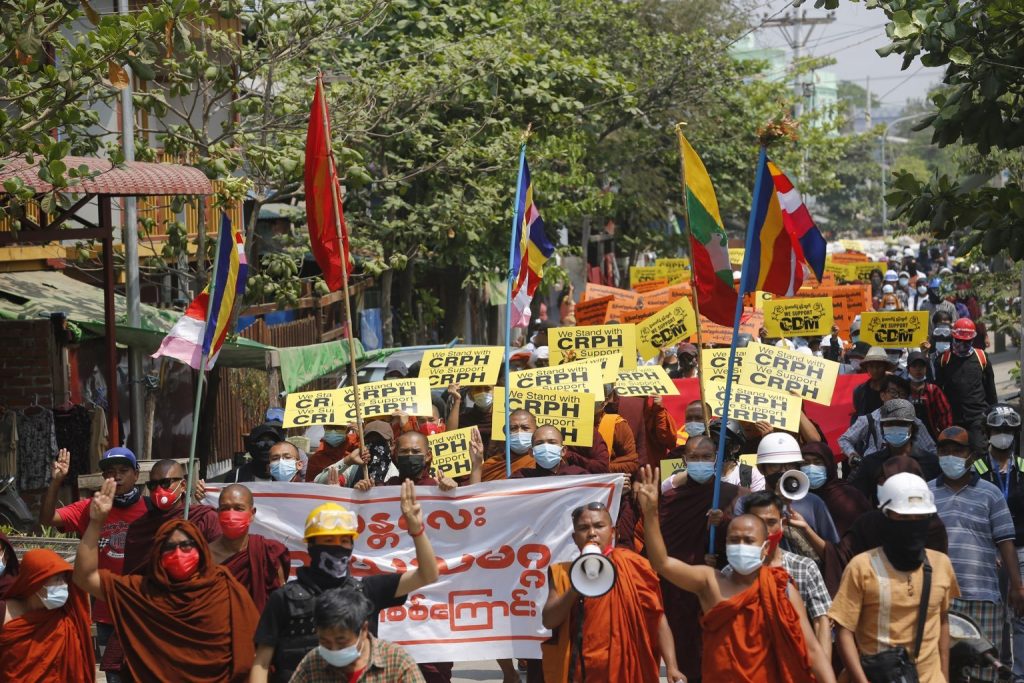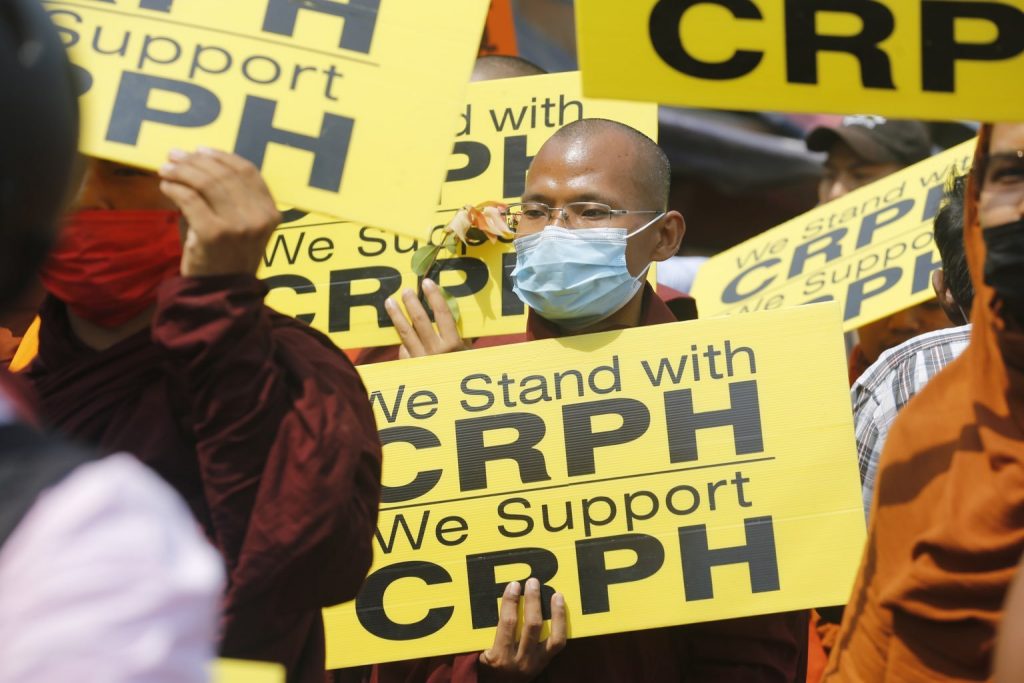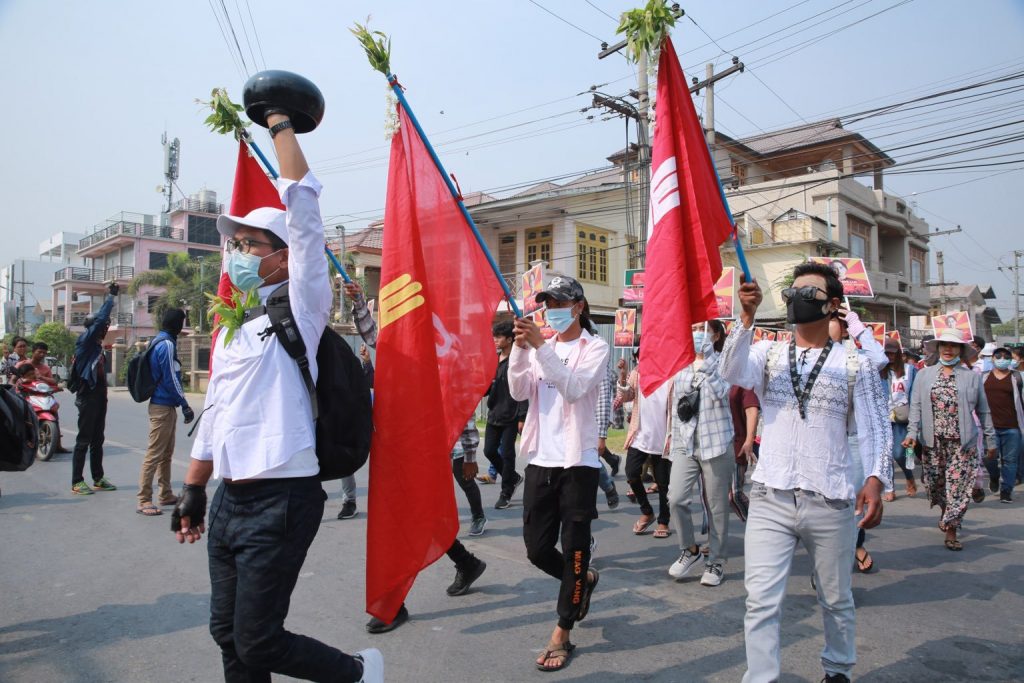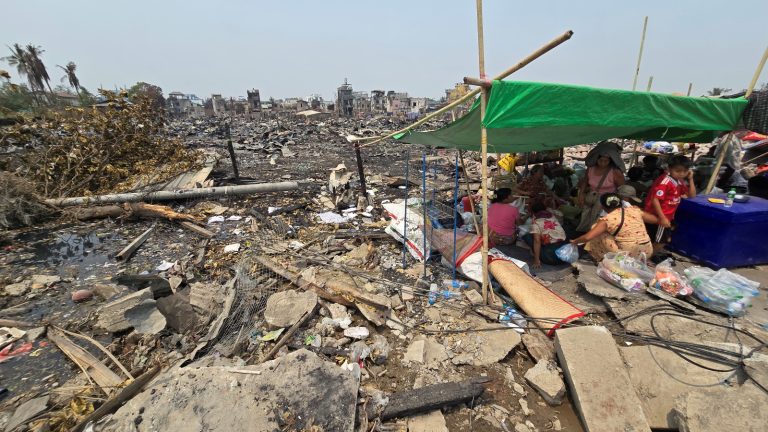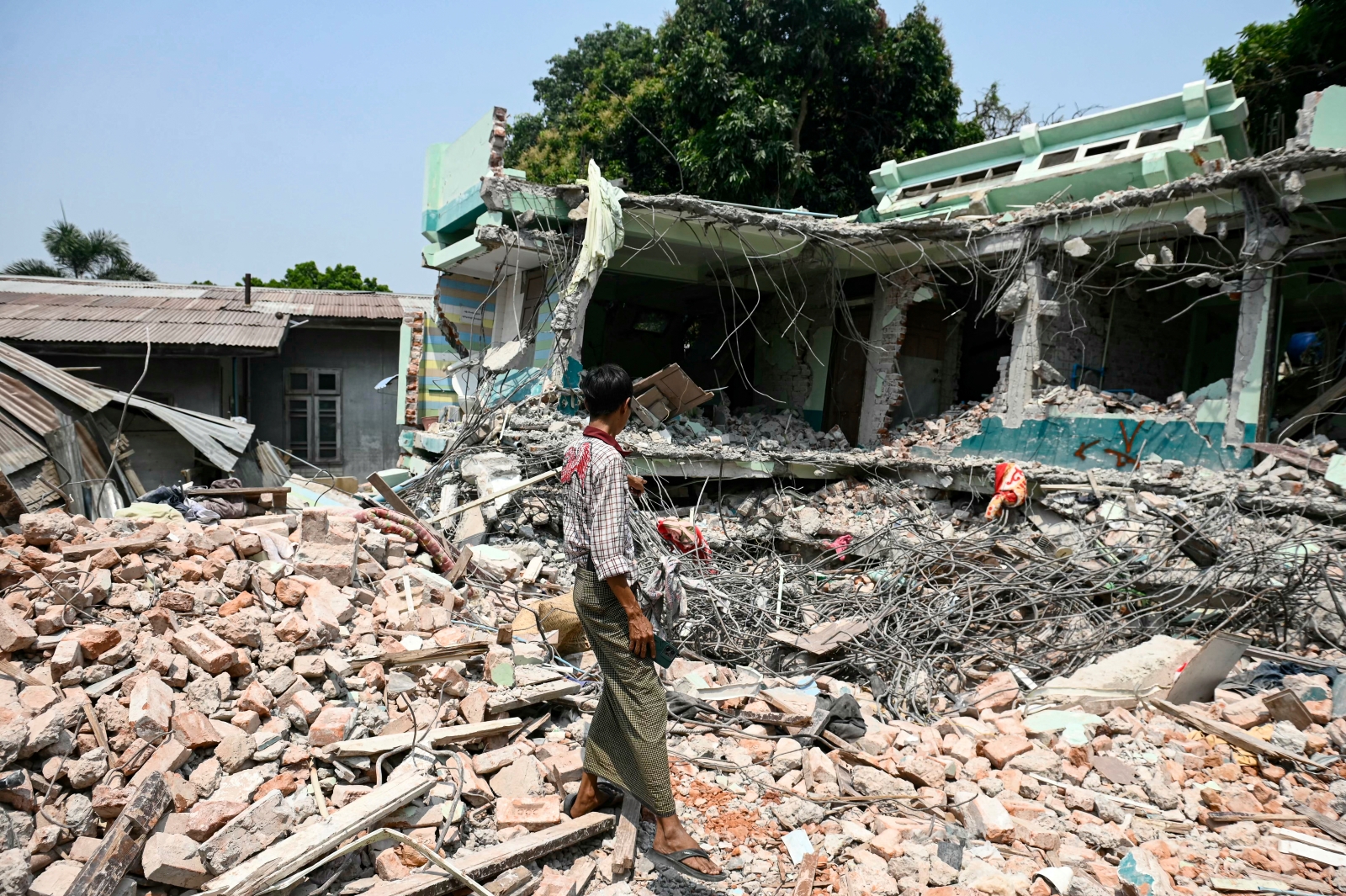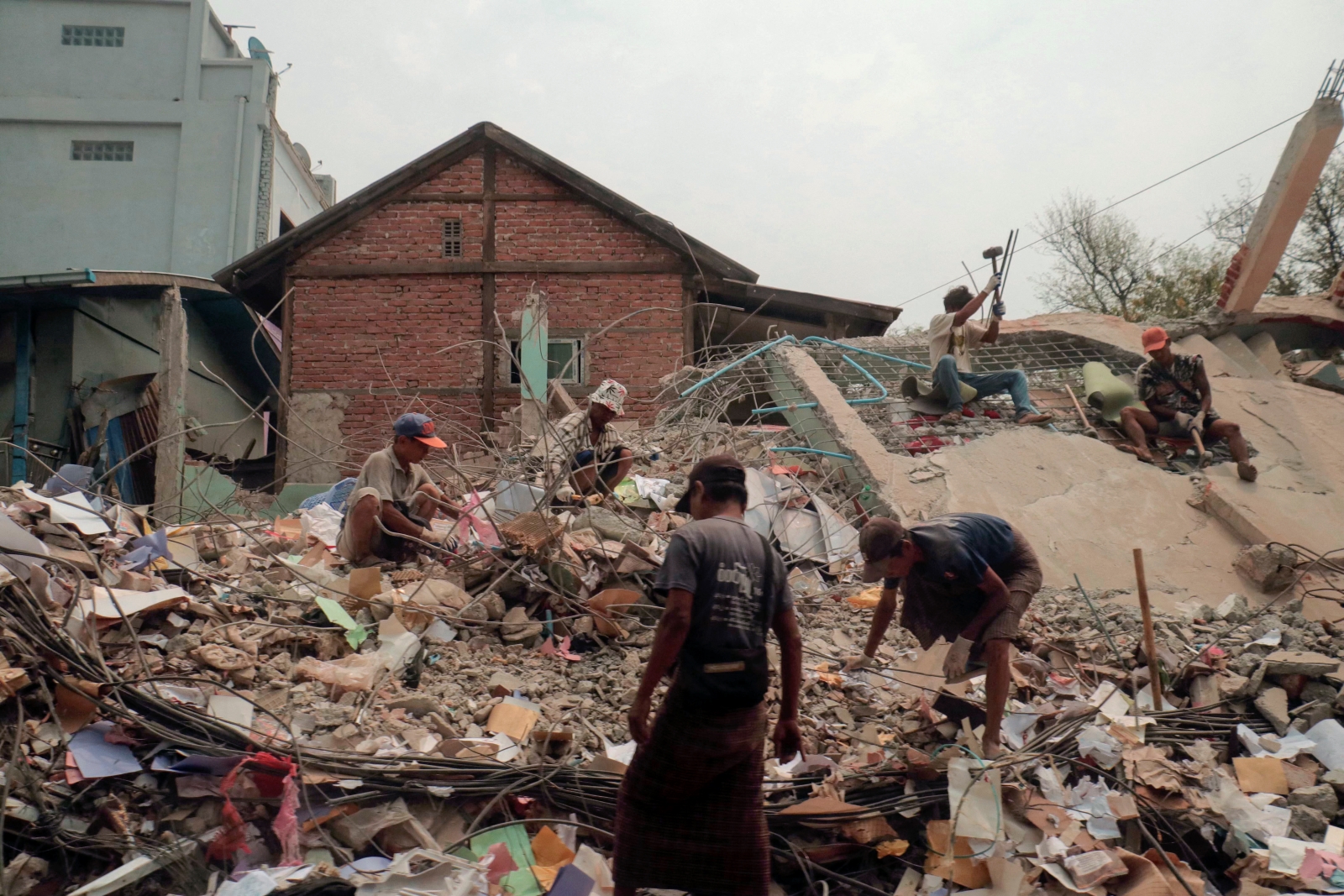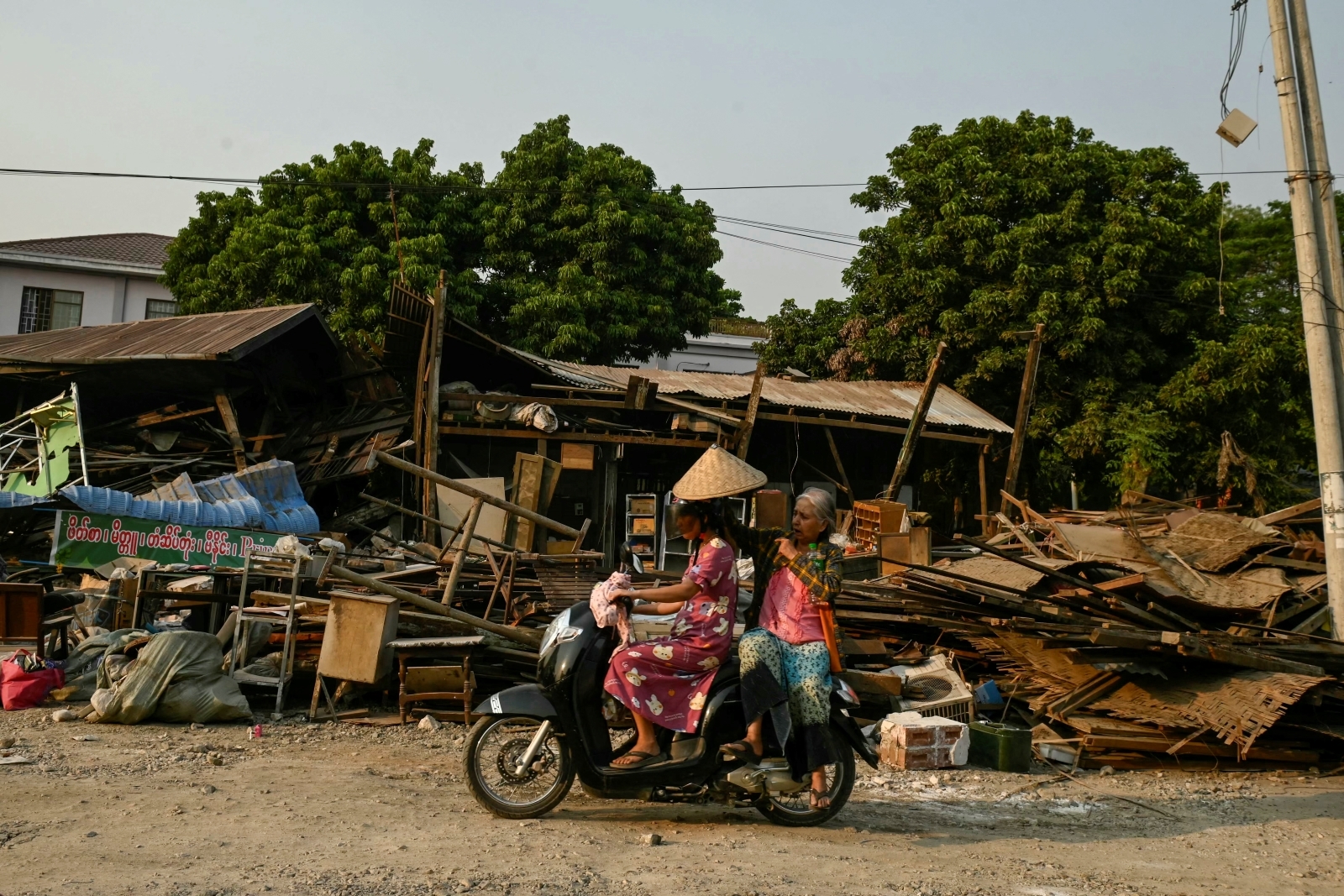Despite ever-growing violence from police and soldiers, an alliance of monks, youth and workers continues to gather each day to demand democracy while keeping its members largely safe.
By FRONTIER
As Myanmar’s second biggest city and a National League for Democracy stronghold, Mandalay has hosted some of the largest anti-coup protests since the February 1 coup. Monks, striking government workers, professional groups, students, activists and ordinary residents have all taken part in mass displays of anger at the regime and its leaders.
Like elsewhere in Myanmar, security forces in the city were initially restrained and tried to negotiate with demonstrators. But as the protests grew and showed no signs of relenting, they began to deploy water cannon, tear gas, rubber bullets, slingshots and, increasingly, live rounds. At least 45 people have been killed and hundreds more injured or arrested in Mandalay, and since late February the number of protesters in the city has gradually dwindled.
For all their efforts, though, joint police and army teams have been unable to crush the Sangha Union Mya Taung Protest March, a procession of thousands of monks and laypeople that has taken place almost daily since February 8 to call for the restoration of democracy. Participants say the presence of monks and the strategy of the group’s leaders has helped to keep participants mostly safe, with just one person killed to date.
The Mya Taung column’s leaders include Sayadaw U Arsara, a prominent monk who in 2007 took part in pro-democracy protests known as the Saffron Revolution, which were brutally crushed by the regime.
He told Frontier earlier this month that he and other Mya Taung protest leaders were committed to forcing the military to give up power.
“Toppling the government elected by the people and stealing state power is ignoring the votes of the people and insulting them,” Arsara said. “I know that the struggle to restore democracy could be a long one. Everyone taking part needs to show patience and unity.”
Because the protest column is led by monks, it’s more secure. Now only the Mya Taung column can go out on the street every day.
Ko Min Htet, a daily participant in the Mya Taung marches
Given Mandalay’s reputation as a home of Myanmar Buddhist culture, it’s unsurprising that monks have been at the forefront of the city’s protest movement. Since the colonial period, they have been heavily involved in politics, with the local population often rallying behind members of the Sangha, as the Buddhist clergy is known.
The group takes its name from the Mya Taung Monastery in central Mandalay’s Maha Aung Myay Township, whose monks are held in high regard by city residents, in part due to their involvement in political and social activism. On February 8, the day of the first march, protest leaders met at the monastery and got the monks’ blessing to use the name “Mya Taung Protest March”. Initially only laypeople took part, but as the response to the demonstrations grew more violent, monks began to participate, too.
On a typical day the march attracts several thousand participants, including around 500 monks, but on some days the number swells significantly. There are usually two processions, one in the early morning and a larger one in the afternoon. Monks only participate in the second march, according to the Sangha rule that mornings are for the daily alms round and subsequent meal.
Although it started at Mya Taung, the group now includes monks from other prominent monasteries in the city and its outskirts, including Mahagandayon, Mogaung and Taungthaman, among others. The monks help to provide laypeople in the column with a degree of protection, as the authorities – most of whom are also Buddhist – are believed to be reluctant to use violence against members of the sangha.
But they aren’t relying on religion alone to keep them safe. In recent weeks the group has varied its start time as well as its route, increasingly using small streets and lanes rather than main roads in order to avoid confronting security forces. By the time police locate the marchers, they have usually been able to disperse.
A Mandalay-based journalist who has covered the protests in the city each day since early February said the Mya Taung protesters remained resolute through the violence and intimidation they faced.
“The Mya Taung protest is like a flower among thorns. It will continue blooming regardless of the crackdown,” the journalist said. “The military regime may kill or arrest one or two demonstrators each day, but more will take their place.”
Making security forces ‘look like fools’
While the Mya Taung protest movement is now led by monks, younger people who identify as members of “Gen Z” make up a large proportion of its members. They are just as determined to fight military rule in Myanmar.
Ko Min Htet, 24, leaves his village at 5am each morning to join the protest. He is one of the column’s frontliners, who have the dangerous job of protecting fellow demonstrators with makeshift shields that are powerless against live rounds.
He said he had been protesting since February 9 and joined the Mya Taung group five days later because it was large and well-organised.
“I haven’t taken a single day off in more than a month,” he told Frontier. “Because the protest column is led by monks, it’s more secure. Now only the Mya Taung column can go out on the street every day.”
The column also includes striking workers from state-run Myanma Railways. Despite threats and pressure to return to work, they continue to take part in the Civil Disobedience Movement, through which government workers are trying to undermine the regime by refusing to work or obey orders. An estimated 80 percent of staff at Mandalay Central Railway Station are on strike and have brought train services in the city – and much of the country – to a halt.
“We don’t like the dictator,” said one Myanma Railways official, when asked why they had decided to join the CDM. “Amay Suu [Daw Aung San Suu Kyi], [President] U Win Myint, and other competent leaders were removed from power and detained … We are going on strike and taking part in the CDM because we do not want to work under them [the military].”
The official, who asked not to be named, said workers were well aware that striking could cost them their jobs, and more. “If we are forced to leave our [staff] housing, we will move. If we are sacked, it can’t be helped. But we will continue fighting for democracy,” he said.
Sure enough, railway workers in Mandalay began vacating their staff housing on March 20 in response to eviction notices for those who refused to return to work.
Despite participants’ best efforts, the Mya Taung column has not always been able to avoid confrontations with security forces.
It suffered its first fatality on March 13 – the deadliest day in the city to date, when seven people were killed. Ko Linn Htet, 19, was shot dead close to the Koe Lone Takar Pagoda in Mandalay’s central Chan Aye Thar Zan Township.
No matter how much they try to use violence to crush us, no matter how much they block and attack our column, we will find a way to break through and make them look like fools.
Ko Phoe Gyi, head of security for the Mya Taung procession
Two days later, mourners were forced to hold a funeral ceremony without the body of the second-year geology student, because the security forces had still not returned it. Despite the tragedy, Linn Htet’s family said they were “proud” of his sacrifice. “I am not despondent [about my son’s death]. I am proud of my son because he gave his life fighting against military rule so we could get back our democracy,” his father told Frontier.
This feeling was shared by Ko Bala, 33, who is a leader of the group’s shield-bearing frontline group. Bala said that while he was upset at losing a close friend, he was proud of Linn Htet’s role in the movement.
Bala said the protest column’s tactics had helped to prevent many more deaths.
“Young people in the Mya Taung protest do not foolishly confront security forces – they use their brains when they are protesting,” he said. “They are fighting for democracy peacefully.”
But the regime hasn’t only used violence to try and disrupt the Mya Taung march. Arsara is facing a charge of incitement under section 505(a) of the Penal Code, although he continues to live in his monastery and the security forces have not yet attempted to detain him.
However, at least two other monks in Mandalay – from Wah Khin Kone Monastery in Chan Aye Thar Zan Township and Bagayar Monstery in Amarapura Township – have gone into hiding after being hit with 505(a) charges.
Security forces also raided Mya Taung Monastery on March 14, purportedly after being told that there were home-made weapons and protesters inside. Eyewitnesses said security forces were “aggressive” towards the monks, demanding they hand over those hiding in the monastery. When the monks refused, the police searched the compound and seized some items, including home-made shields, but made no arrests.
Shortly after, the Saffron Sangha Network Upper Myanmar Mandalay and the Sangha Union Mandalay issued a statement saying that if the harassment of monks continued, then all members of the clergy in Myanmar would come out to protest against the military regime.
On March 20 and 21, the Mya Taung group decided against staging morning protests, because the absence of monks made protesting too dangerous. But despite the increased risk of participants being arrested, injured or killed, they returned to twice-daily demonstrations on March 22.
“It’s not easy to protest against authorities when they have weapons. Now is the time for all protesters to unite in revolting against the regime,” said Ko Phyo Gyi, who is responsible for security in the Mya Taung group. “No matter how much they try to use violence to crush us, no matter how much they block and attack our column, we will find a way to break through and make them look like fools.”
One of the group’s leading monks echoed this sentiment. “We have been staging protests in the face of great danger – we could be arrested at any time – but we don’t have any choice,” he said.


